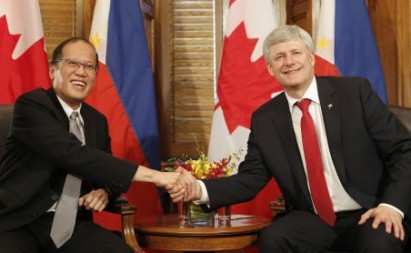Editor’s note: Cesar Polvorosa Jr. is a business school professor of economics, world geography, and international business management in Canada. He is also a published writer in economics, business, and literature.
It was a short visit but long on potential benefits. President Benigno S. Aquino visited the major Canadian cities of Ottawa, Toronto, and Vancouver last May 7-9. He met with Prime Minister Stephen Harper and other senior Canadian government officials, top business executives, and members of the Filipino community.
Some critics pointed out that the visit had been politically motivated because of the Canadian Federal elections scheduled for October this year and that the ruling Conservative Party of PM Harper had been courting the immigrant vote. For instance, Prime Minister Modi of India had also been a recent state visitor. Both Filipinos and Indians comprise huge immigrant communities in Canada.
Regardless of the political capital or advantages that may accrue to both President Aquino and Prime Minister Harper what is clear are the potential economic benefits from enhancing the ties between the two countries.
Highlights of Philippine and Canada economic relations
The Philippines as a source country of permanent residents for Canada had been consistently ranked no. 2 or no. 3 for the past several years with China and India as usually the top two source countries. The Philippines was actually the no. 1 source country for 2010-2012 which is quite significant since the Indian and Chinese populations are at least 10 times bigger than the Philippines. In 2013, 29,539 Filipinos became permanent residents of Canada which is more than double of no. 4 source country Pakistan.
With such substantial annual inflows there are now about 700,000 Filipinos in Canada. PM Harper in his remarks in the joint press conference with President Aquino in Ottawa noted that Tagalog is the most rapidly growing language in Canada. It is clear that the economic relationship between the two countries had been below the radar for years. For decades both countries prioritized their economic relationships with Japan, China, South Korea, and US.
In 2014, Philippine merchandise exports to Canada totaled $598 million while imports from Canada reached $317 million for total merchandise trade value at $916 million which is a mere 0.73% of total merchandise trade (DTI).
Trade with Canada is ranked a paltry no. 14 in the total direction of trade of the Philippines. Officials noted that the Philippines is Canada’s sixth largest trading partner in Southeast Asia – which is actually stating that the trade is at low levels. Evidently, there is a large potential to expand economic relationships between the Philippines and Canada.
Bangko Sentral ng Pilipinas figures indicate that overseas Filipinos cash remittances from Canada reached $651 million in 2014 and ranked no. 8 close behind Hong Kong and pales in comparison to Japan ($982 million) and the US ($10.4 billion).
For the first quarter 2015, tourists from Canada accounted for 46,756 arrivals showing a 9.14% increment over the previous year which is a mere 3% of tourist arrivals during the period, according to the Department of Tourism.
Canada: a vast and prosperous country
Canada is a vast country of 10 million square kilometers, second in size only to Russia. The country is so huge that the distance from Vancouver along the Pacific Ocean to Toronto in Central Canada at 3,369 kms is significantly longer than the distance from Manila to Tokyo, Japan. In fact, from Vancouver to Halifax, Nova Scotia along the Atlantic Ocean at 4,442 kms is even slightly further than the distance from Manila to Chennai, India.
Most of the 35 million population live along the south- within 250 kms of the US border. In the far north of the country, the Northwest Territories, Nunavut, and Yukon comprise third of Canada’s land mass but the population is only about 100,000. Much of the north is made up of the tundra which are rocky plains where trees don’t grow and the soil is permanently frozen (the permafrost) because of the very cold Arctic climate.
Even in the province of Ontario, which has about a third the population of the country, it’s clear that Canada is a sparsely populated country. The area of Ontario is 1.08 million sq kms, which is 3.6 times the size of the Philippines and yet it has only about 13 million people compared to Metro Manila’s 12 million and total Philippine population of about 100 million.
A major indicator of the prosperity of Canada is that while it is ranked only no. 37 in the world in population its Gross Domestic Product (GDP) or size of the economy is no. 11. This implies that Canada has a high GDP per capita which at $50,397 (IMF, 2014) makes it ranked 15th in the world in per capita income similar to Austria, Finland, and Netherlands.
An even more impressive performance of Canada is in terms of ranking in HDI (Human Development Index) which was developed by the UNDP in the mid 1990s as an alternative measurement to GDP and considered by many to be better as it includes life expectancy and literacy other than income. Canada is ranked no. 8 in the world for 2013 and classified as a country having “Very High Human Development.” By comparison, the Philippines is ranked #117th in the world for HDI and classified as country with “Medium Human Development.”
So what’s an important basis for enhanced economic relationship between Canada and the Philippines? It’s the major differences in physical features, natural resource endowments, and climate.










